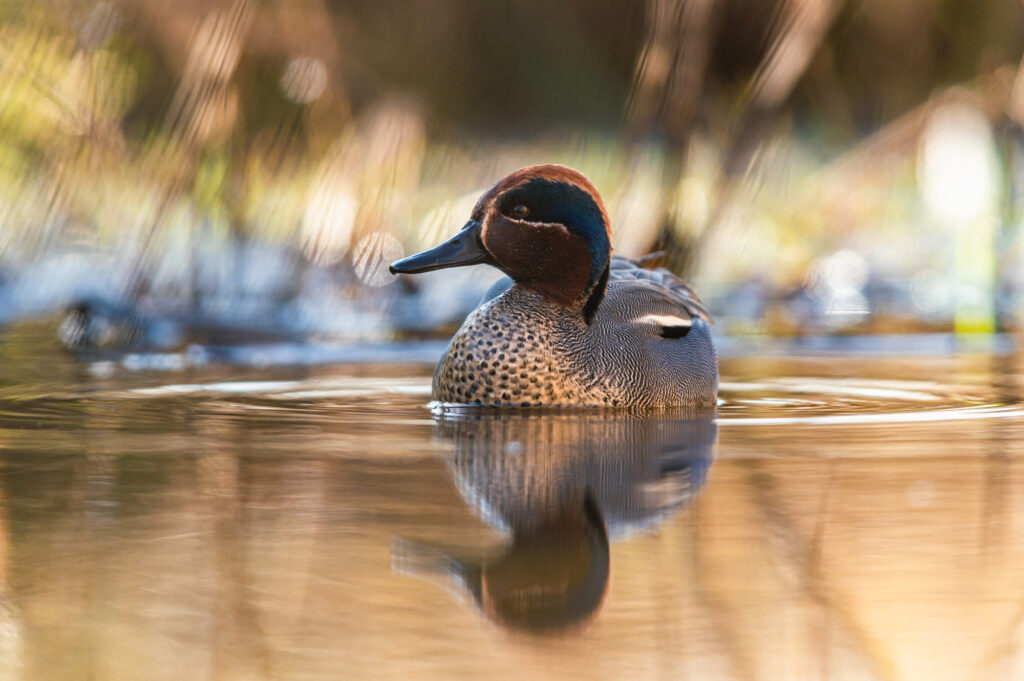Oklahoma has six National Parks, 35 State Parks, more than 200 lakes, and over 78,000 miles of rivers. What a wonderful state for wildlife and birds – especially ducks!
There are more than 20 species of ducks regularly found in Oklahoma. You’ll find some ducks here year-round, but other ducks only stay for the winter or summer.
Ducks live in the state’s rivers and lakes, as well as marshes, wetlands, agricultural ponds, streams, parks, and even backyards.
How to Identify Ducks
If you want to become an expert at identifying ducks, you’ll need to familiarize yourself with the following characteristics of each duck:
- Size (height, weight, length, and wingspan are great measurements)
- Silhouette
- Habitat (may change from season to season)
- Behaviors (such as dabbling or diving for food)
- Migration habits
- Color patterns (most ducks are sexually dimorphic, and some ducks change appearance between breeding and non-breeding seasons)
Dabbling Ducks & Diving Ducks
Ducks are divided into two categories: dabbling ducks and diving ducks. To differentiate between these two ducks, just take a look at how they get their food!
Dabblers dip their heads under the water and leave their tails sticking straight up into the air. They don’t submerge themselves, which is why they are usually found in shallower waters.
Diving ducks, on the other hand, dive deep under the water to reach aquatic plants, insects, fish, crustaceans, or whatever makes up their diet. They will disappear underwater and then reappear up to a minute later.
In our list of 21 duck species that you’ll find in Oklahoma, we’ve labeled each of them as either a dabbler or a diver.
Keep in mind that diving ducks are sometimes called “sea ducks,” too.
American Wigeon (Dabbling Duck)

- Mareca Americana
- Length: 16.5 – 23.2 in (42 – 59 cm)
- Weight: 19.1 – 46.9 oz (540 – 1330 g)
- Wingspan: 33.1 in (84 cm)
American Wigeons breed in western Canada, but they spend their winter in much of the United States, including Oklahoma.
In fact, they are widespread in Oklahoma and can be found in freshwater marshes, lakes (including large, deep lakes), and ponds.
In coastal states, they also inhabit coastal estuaries, as they are comfortable in both salt and freshwater settings. Oklahoma has some saltwater lakes and marshes, including the ones in Salt Plains State Park.
American Wigeons are medium-sized ducks.
Males are gray and have green stripes on the sides of their heads and a white cap, which gives them the nickname “the baldpate.” Females are brown-bodied with grayish-brown heads. Both males and females have pale-colored bills.
They build their nests on the ground, near the water, and their diet consists of insects, aquatic plants, and invertebrates.
Barrow’s Goldeneye (Diving Duck)
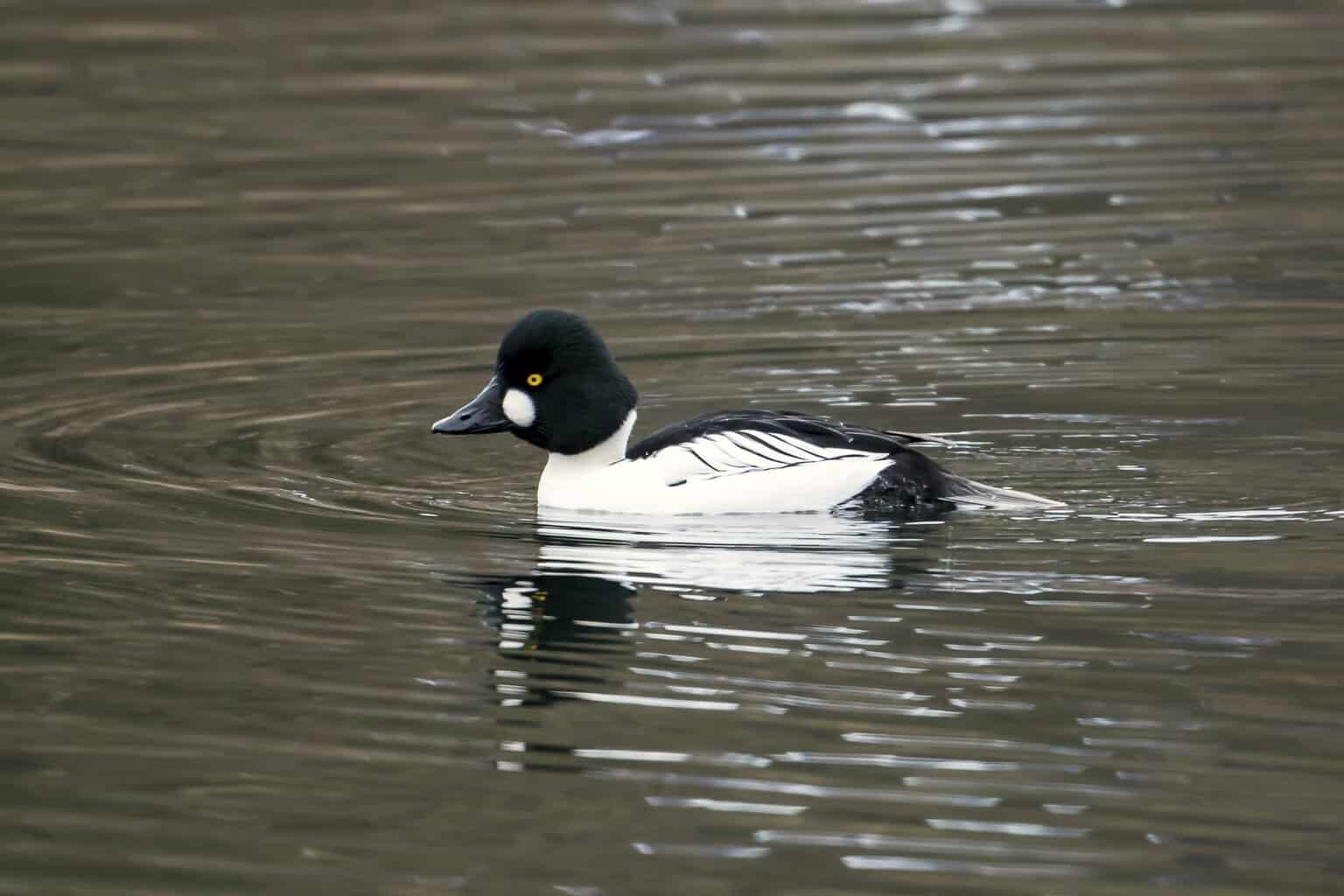
- Bucephala islandica
- Length: 16 – 20 in (41 – 51 cm)
- Weight: 38.4 oz (1088 g)
- Wingspan: 30 – 32 in (76 – 81 cm)
You’ll only find Barrow’s Goldeneyes in Oklahoma during the winter. Specifically, they are uncommon residents between December and mid-February. They are more frequently spotted in the Pacific Northwest.
If you do see these ducks in Oklahoma, you may see them in the same place next year. Barrow’s Goldeneyes have very predictable habits, so a pair of ducks will often return to the same location year after year.
Barrow’s Goldeneyes are cavity-dwellers who make their nests in abandoned cavities in trees that have been left behind by other birds and ducks.
They especially like the cavities created by woodpeckers. If there isn’t a good cavity available, they will nest in cliffs and in trees.
Male Barrow’s Goldeneyes have dark purple heads that look black from a distance. They have a white crescent on their cheek and bright golden eyes that give them their name.
Females are gray and have dark brown heads and a white neck collar. She has a yellow-orange bill and the same golden-yellow eyes as her male counterparts.
Their diet is almost exclusively insect-based, which is why they do not live on waters with insect-eating fish. They don’t want to compete with the fish for their food!
Blue-Winged Teal Duck (Dabbling Duck)
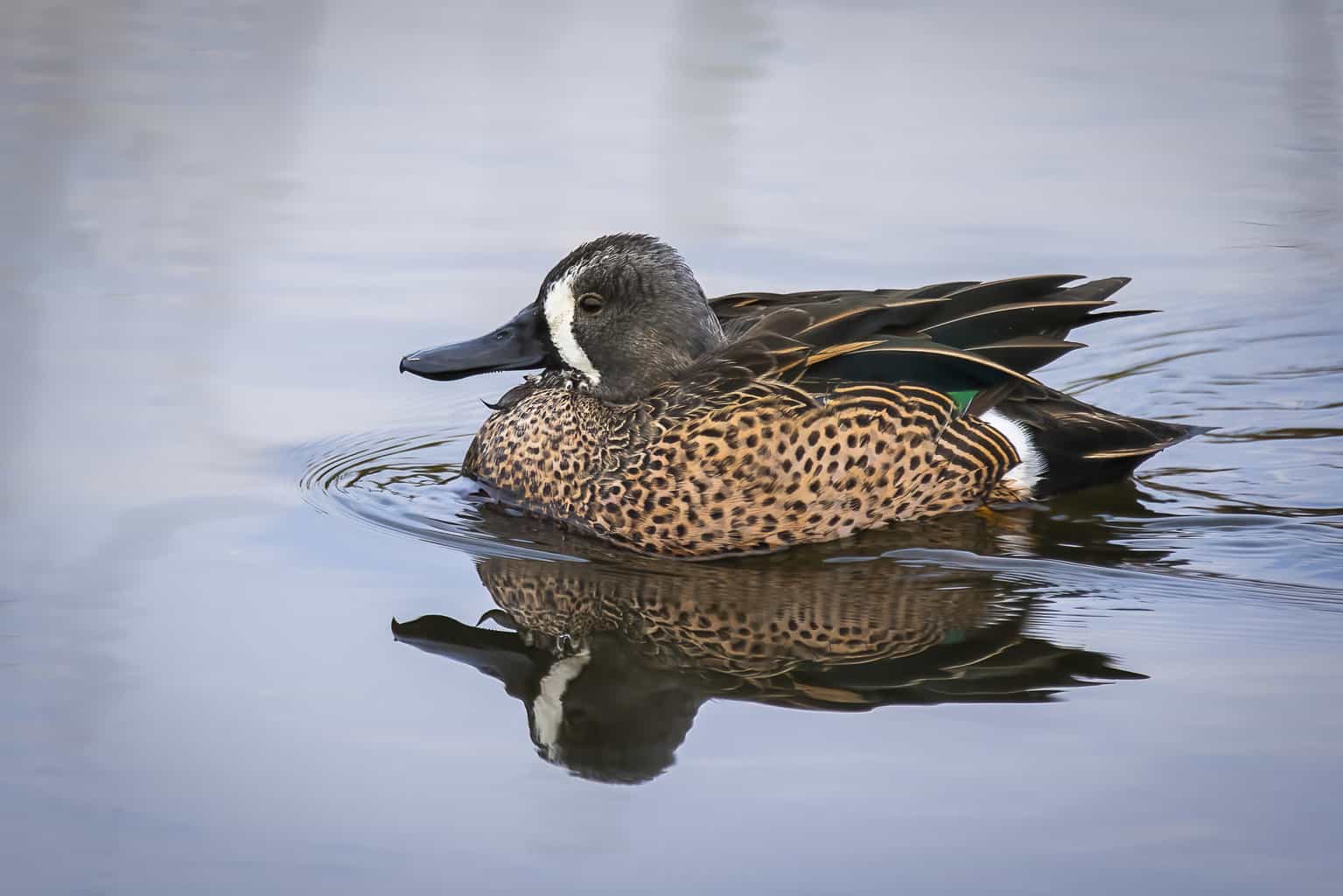
- Spatula discors
- Length: 15 – 17 in (38 – 43 cm)
- Weight: 19.18 oz (544 g)
- Wingspan: 23 -31 in (58 – 79 cm)
Blue-Winged Teal Ducks are typically migratory birds in Oklahoma, which means most of them don’t live here in the winter or the summer but stop here as they migrate between their breeding and wintering territories.
You’re most likely to see a Blue-Winged Teal Duck between August and November and again between March and May.
The male Blue-Winged Teal Duck is small with a blue-gray head and a brown spotted body.
He has a white crescent on his face, in front of his eyes, as well as a blue shoulder patch and a green speculum (we’ll mention the speculum elsewhere in this list – the speculum is a patch on the wings that usually shows up in flight and is shaped like a rectangle.).
Females don’t have the same white crescent, but they are spotted like a male.
Blue-Winged Teal Ducks eat aquatic plants and insects. They like calm waters with plenty of vegetation.
Their diet is primarily made up of aquatic plants and insects. They prefer to live in calm waters, especially ponds where there is plenty of aquatic vegetation.
Unfortunately, Blue-Winged Teal Ducks have high mortality rates, and they may play a significant role in spreading avian influenza to commercial poultry farms.
Bufflehead (Diving Duck)
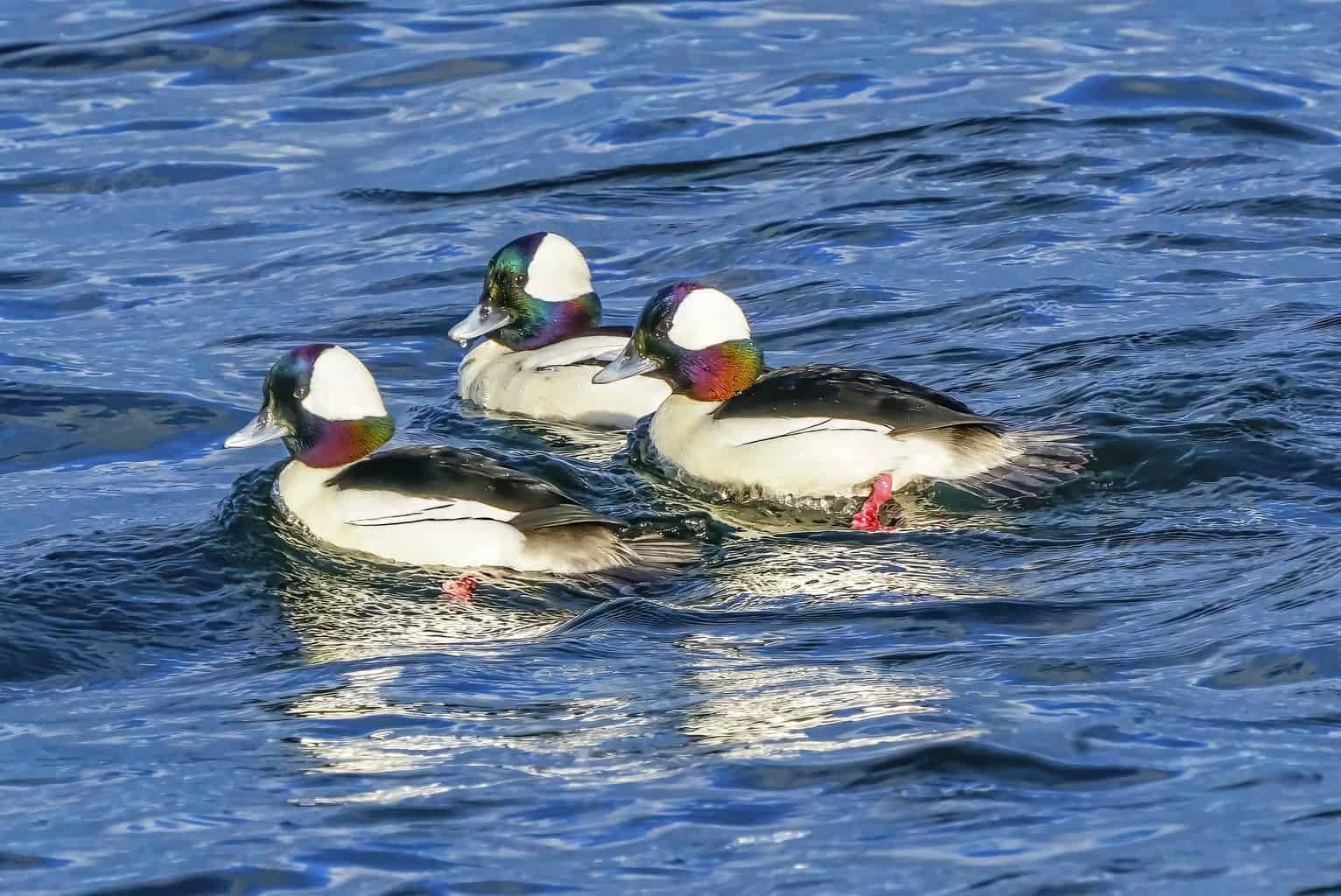
- Bucephala albeola
- Length: 13 – 16 in (33 – 41 cm)
- Weight: 21.16 oz (600 g)
- Wingspan: 20 – 24 in (51-61 cm)
The Bufflehead’s name comes from its big, fluffy, and round head. Both sexes have the same head shape, but otherwise, they are quite dissimilar from one another.
Males have a large white patch behind their eyes that creates a color block pattern of iridescent green, iridescent purple, and white. They have white bodies and black backs.
Females are gray and black-bodied with a dark brown head and a white patch below their eyes.
Often, male ducks are easier to identify from a distance than females. Buffleheads are great because it’s easy to spot both sexes from pretty far away! Just watch for the big white patch on the male’s head and the little white patch on the female’s cheek, and you’ll have spotted a Bufflehead.
Buffleheads, like many other ducks, live in abandoned tree cavities. They are winter residents in Oklahoma, and you’ll usually see them in pairs, as they are monogamous with long-term partners.
They prefer forests that include both coniferous and deciduous trees. If you live close to this preferred habitat, consider building a nesting box, as Buffleheads use them like they use tree cavities.
Canvasback (Diving Duck)
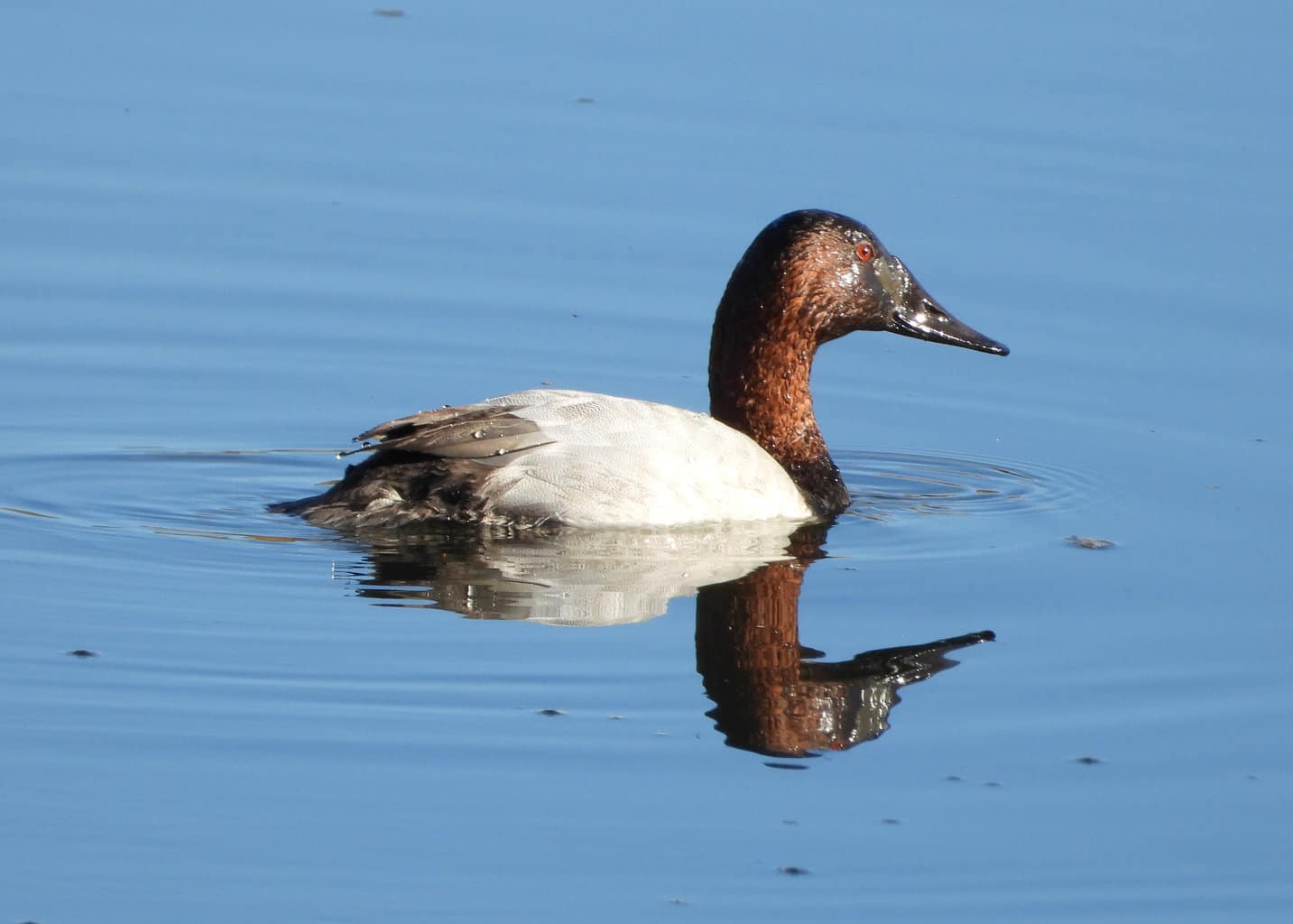
- Aythya valisineria
- Length: 19 – 24 in (48 – 61 cm)
- Weight: 58.48 oz (1657 g)
- Wingspan: 28 – 36 in (71 – 91 cm)
Canvasbacks, with their long sloping foreheads, large bills, and distinct color patterns, are winter residents of Oklahoma. They return to western Canada in the spring.
Males have a rich, dark copper head with a black chest and white gray body. Males have red eyes. Females are much lighter in color, and their eyes are dark black.
The nest of a Canvasback is incredibly durable. It has to be, as these are the largest diving ducks in North America.
They are found in marshes where there are plentiful aquatic plants and invertebrates.
Cinnamon Teal Duck (Dabbling Duck)
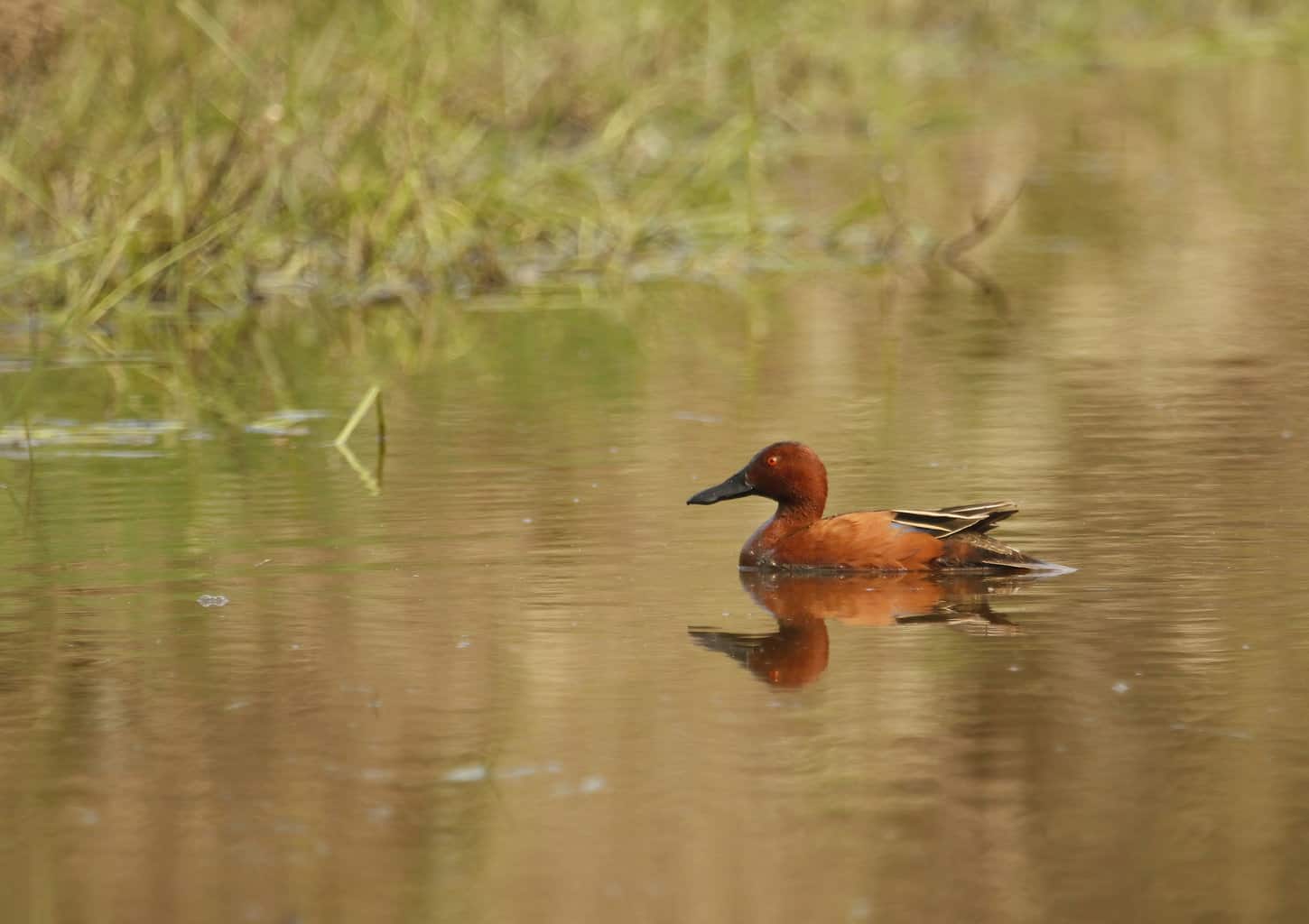
- Spatula cyanoptera
- Length: 14- 17 in (36 – 43 cm)
- Weight: 16.4 oz (465 g)
- Wingspan: 24 – 30 in (61 -76 cm)
Male Cinnamon Teal Ducks look quite different in the summer than they do in the winter.
In the breeding season, they are vibrantly reddish-orange with bright red eyes, a pale blue shoulder area, and a green speculum on the wings. The body is the color of burnt cinnamon.
In the winter, which is the only time you will see them in Oklahoma, they lose their vibrancy and look more like females. Females have a scaled pattern across the chest and body.
They prefer shallow, alkaline lakes and freshwater ponds.
Even though many ducks are monogamous and choose to stay partnered for several years, Cinnamon Teal Ducks choose a new partner every year.
Common Goldeneye (Diving Duck)
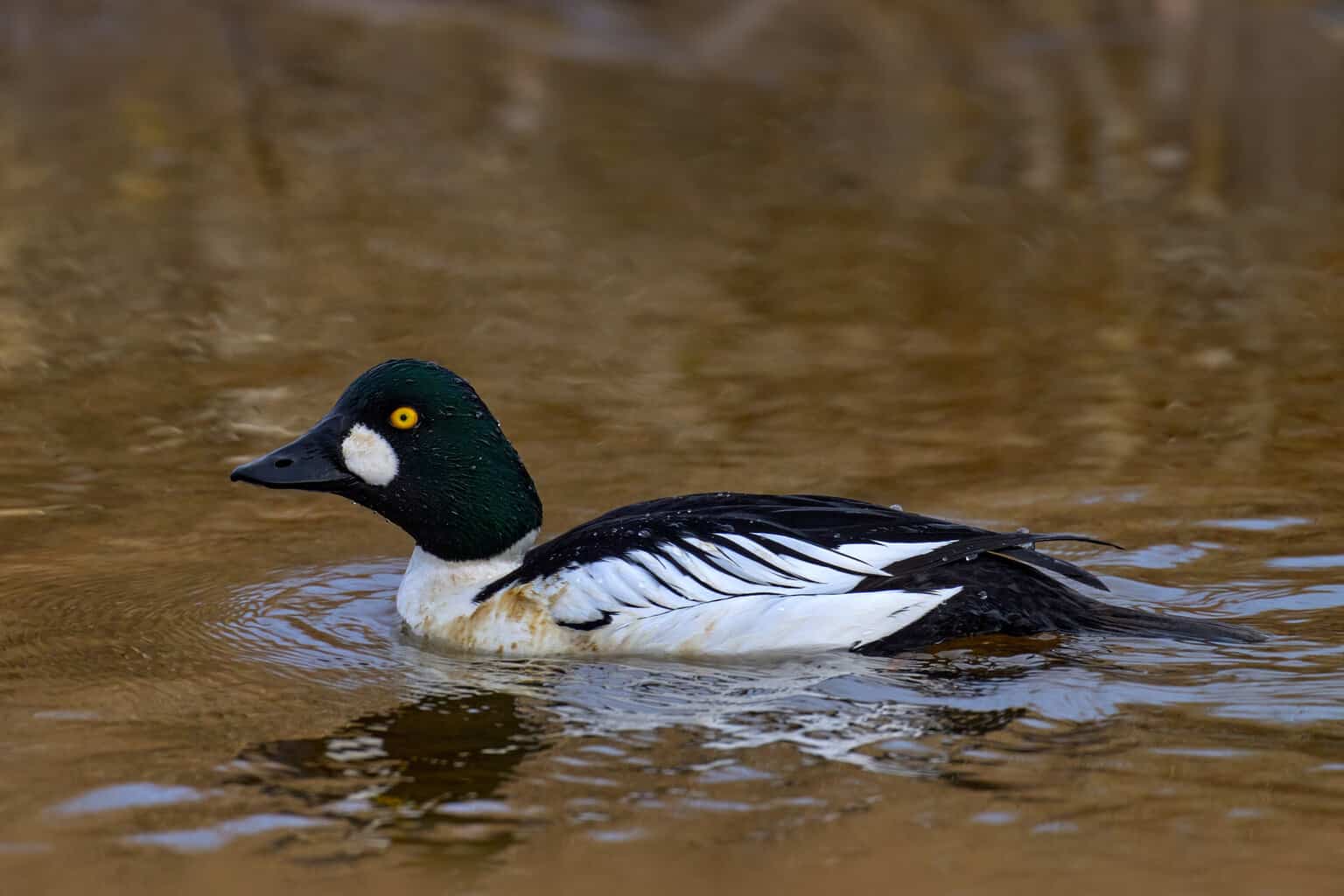
- Bucephala clangula
- Length: 16-20 inches
- Weight: Approximately 1.8 pounds
- Wingspan: 30.3-32.7 inches
Like Barrow’s Goldeneye, the Common Goldeneye also has notable yellow eyes.
During the breeding season, males are green and white. Their feathers are such a dark shade of green that they are often mistaken for being black and white. Males also have two white patches: one on the cheek and one on the wings.
Females have gray bodies and brown heads. The female Common Goldeneye lacks a cheek patch, but, like the male, she has a white patch on her wings.
Although they breed throughout most of Canada, they spend their winter months across almost the entire US. They are very rare in southern Texas and parts of the southeast, but they are not rare during the winter in Oklahoma.
Because you’ll only see them here in the winter (between November and May), you will likely only see the more muted appearance of the non-breeding season male. They will be found on large lakes and rivers.
Female Common Goldeneyes are prone to fighting amongst themselves, and this can cause their ducklings to scatter and become separated from their mothers.
When this happens, they may find a new nest to join. A collection of ducklings from different broods is called a creche.
Common Merganser (Diving Duck)
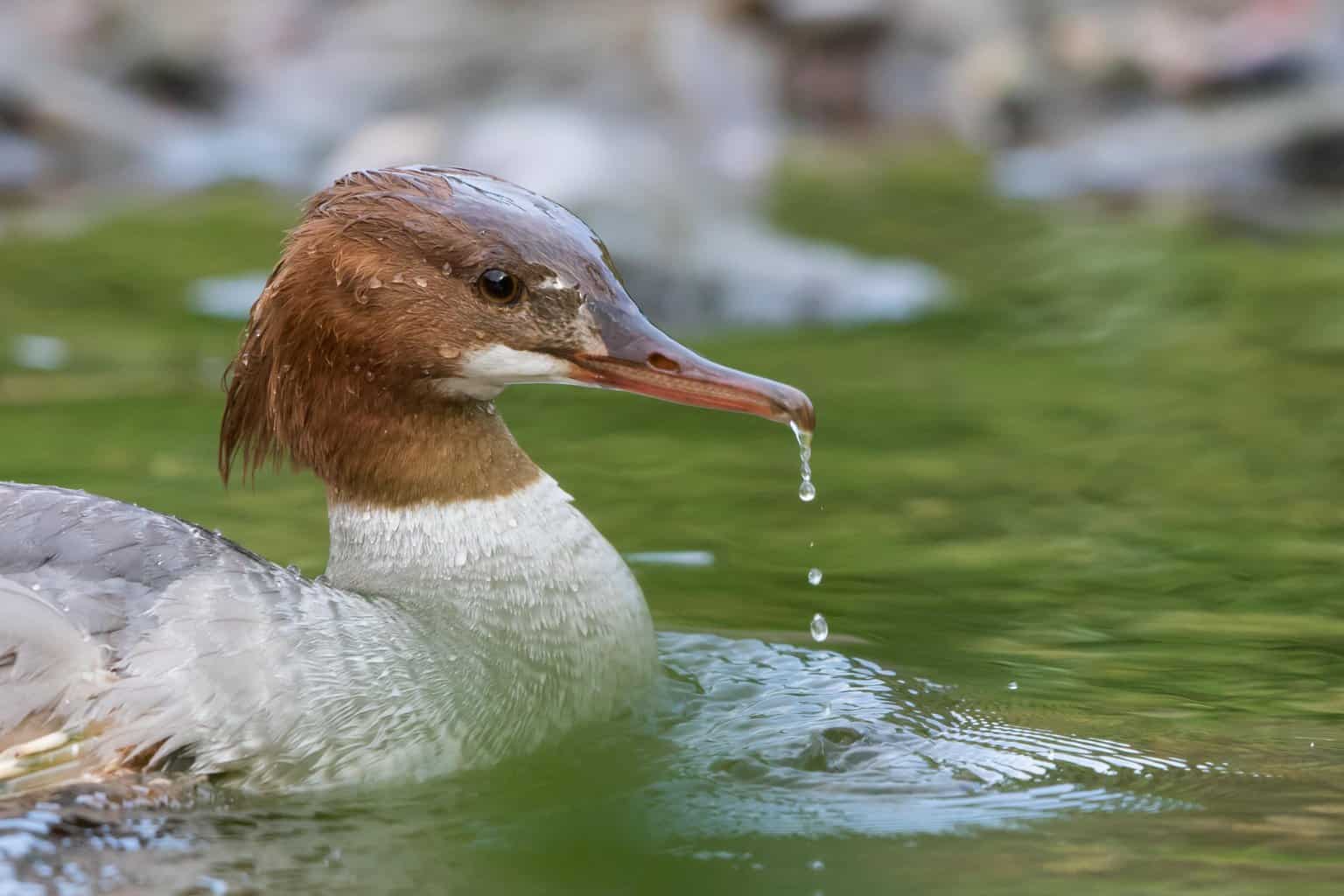
- Mergus merganser
- Length: 22 – 27 in (56 – 69 cm)
- Weight: 60.8 oz (1723 g)
- Wingspan: 31 – 37 in (79 – 94 cm)
The Common Merganser is known for its attention-grabbing crest.
Male Common Mergansers have a bright red bill, black eyes, and a greenish-black head. His crest is only sometimes visible.
Females have a much more noticeable cinnamon-red color with a shaggy crest. In addition to her easily recognizable head, she also has a white patch on her chin, a white breast, a white belly, and a gray back.
Males and females alike have sharp, serrated bills for ripping apart fish.
You’ll find Common Mergansers in Oklahoma in the winter, typically close to their tree cavity nests. Sometimes, they’ll also choose to nest in nesting boxes. When nothing else is available, they’ll nest in the crags of a cliff.
Regardless of where their nest is, hatchlings immediately leave the nest in search of food. Their mother will help them find food, but she lets them do most of the work on their own.
These are very independent ducks!
Gadwall (Dabbling Duck)
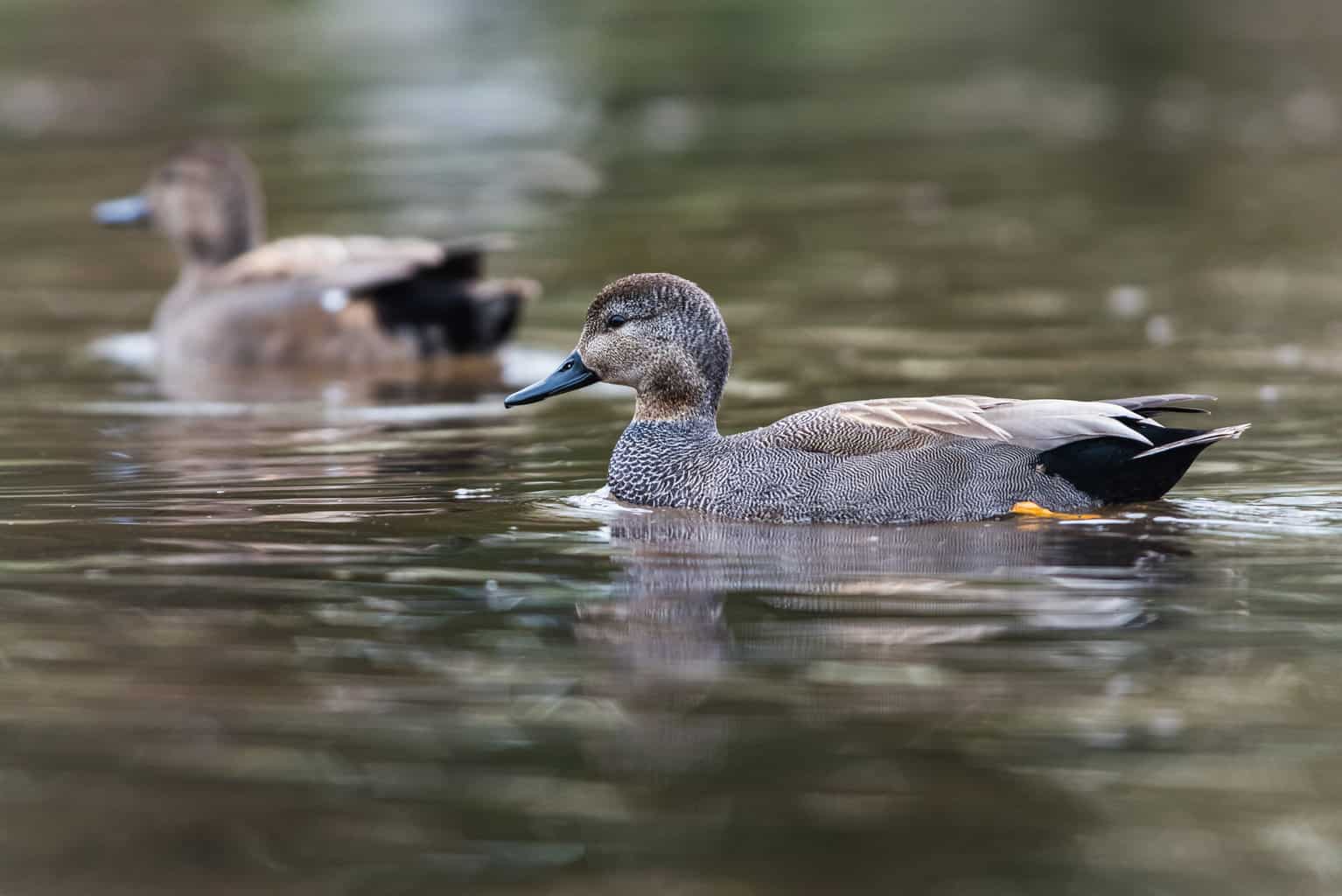
- Mareca strepera
- Length: 19 – 23 in (48 – 58 cm)
- Weight: 35.27 oz (1000 g)
- Wingspan: 31 – 36 in (79 – 91 cm)
Gadwalls are common non-breeding residents in Oklahoma. This means they’re plentiful in the state, but only in the winter.
Males are grayish-brown and have a black spot on their tails. Females are patchy in dark and light brown.
Both sexes have white wing markings, but, in general, they are a bit harder to spot than other duck species. Sometimes, it’s easiest to identify a Gadwall by ruling out the other options.
They like saltwater marshes and city parks for their wintering territory. They prefer areas with plenty of aquatic grasses along the edges of the water, as they are excellent at hiding among these plants.
Their coloring helps to camouflage them from predators.
Human birders are perceived as predators, especially because humans frequently hunt ducks for sport.
Greater Scaup (Diving Duck)
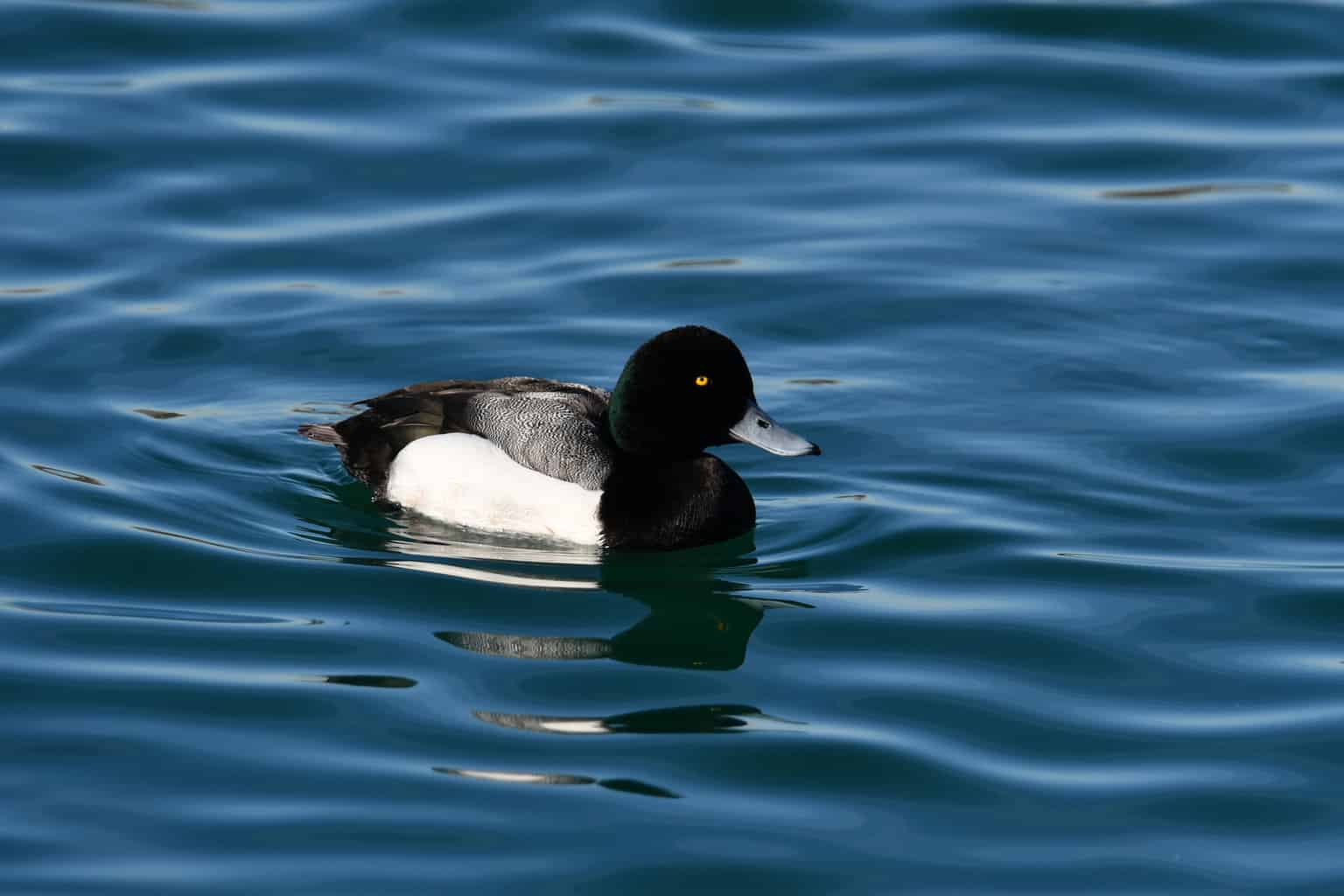
- Aythya marila
- Length: 15-22 inches
- Weight: 1.5-2.9 pounds
- Wingspan: 28-33 inches
You may have heard the Greater Scaup referred to as a Bluebill. Their broad, slate-blue bill helps them stand out from other ducks.
Two types of scaup are found in North America: Greater Scaup and Lesser Scaup. Both are found in Oklahoma.
In the eastern half of the state, they are winter residents. Central Oklahoma sees them during their migration periods, and they do not typically visit the panhandle.
Male Greater Scaup are white-bodied with brown and black barring on their backs. They have an iridescent green head.
Females are light brown with dark brown heads.
During the winter, which is when you’ll see them in Oklahoma, males become more muted in appearance, and they look a bit like a hybrid between the female and breeding season male. He will have a brown and gray body with a black head.
Green-Winged Teal Duck (Dabbling Duck)
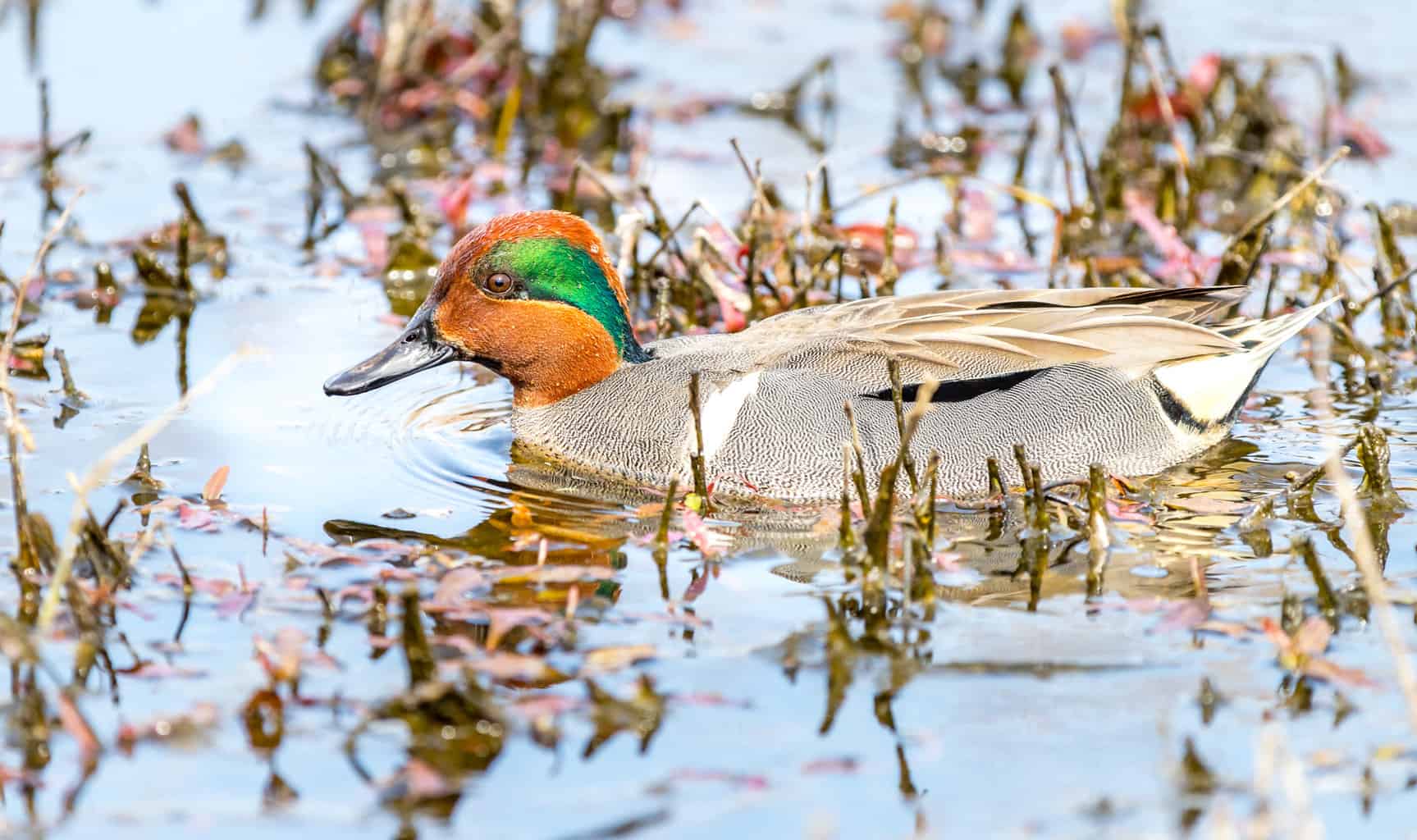
- Anas crecca
- Length: 12.2 – 15.3 in (31 – 39 cm)
- Weight: 4.9 – 17.6 oz (140 – 500 g)
- Wingspan: 20.5 – 23.2 in (52 – 59 cm)
The Green-Winged Teal Duck is a small dabbling duck.
Males have a green stripe from the eyes to the back of the head. Females are brown with a yellow streak that runs along the tail. Both males and females have an iridescent green speculum that gives them their name.
Most ducks in Oklahoma are winter residents. That’s true of Green-Winged Teals, as well. They are incredibly plentiful, numbering in the tens of thousands when they gather in massive groups. Typically, though, they are seen in groups of around 15.
Green-Winged Teal Ducks can do something that not every duck can do. They don’t need a running start to take off from the water. Instead, they can easily segue from floating to flying, without much of a transition at all!
Hooded Merganser (Diving Duck)
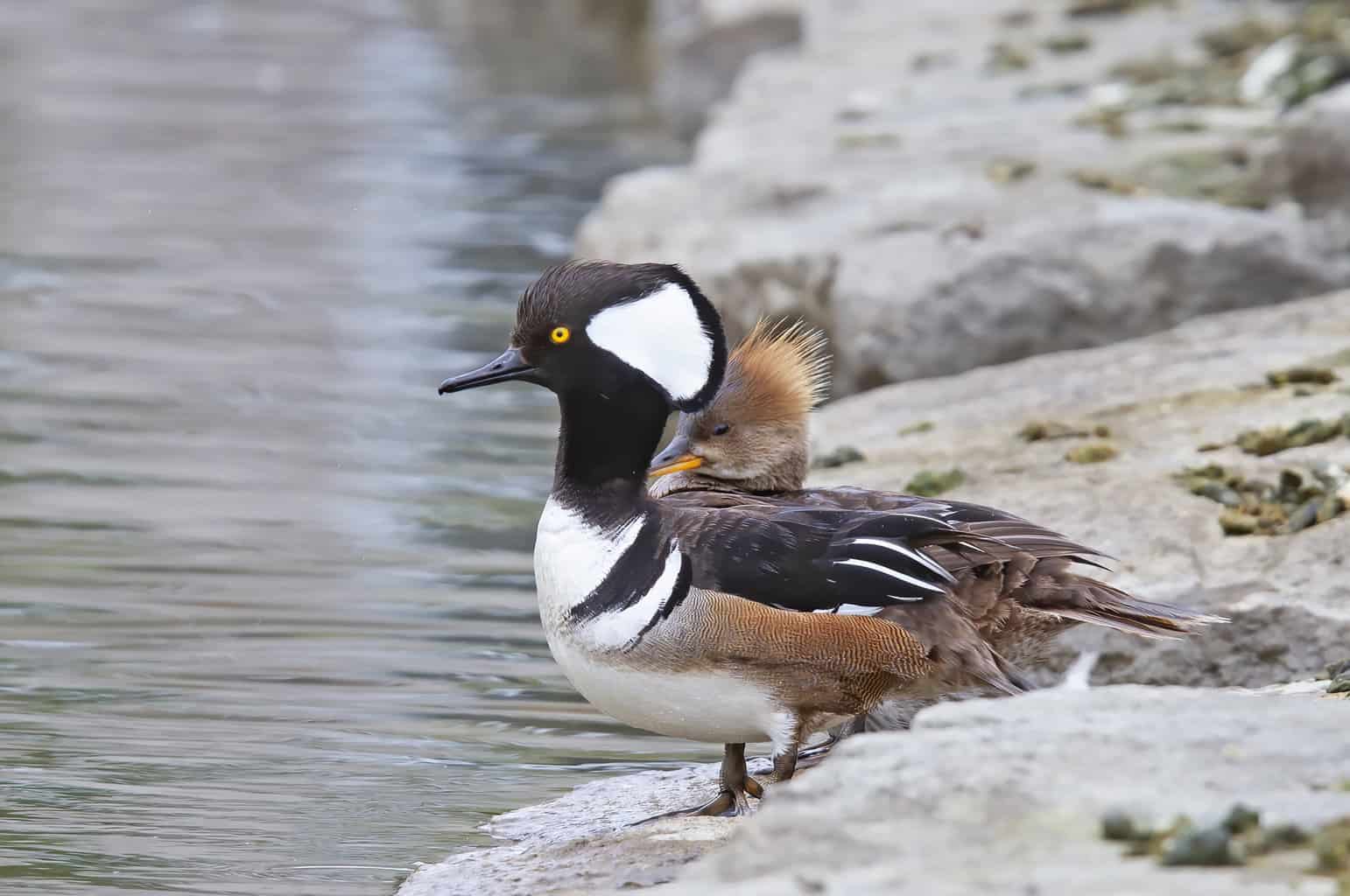
- Lophodytes cucullatus
- Length: 16 – 19 in (41 – 48 cm)
- Weight: 32.09 oz (909 g)
- Wingspan: 24 – 26 in (61 – 66 cm)
Hooded Mergansers live in Oklahoma for the winter after migrating from the northern Midwest.
There are also Hooded Mergansers who migrate to the Pacific Coast for the winter, but that’s because they are year-round residents of the Northwest.
Male Hooded Mergansers have a crest that they can lower or raise, which changes the shape of their head. Sometimes, their heads look round-ish and tall; other times, their head is small and angled backward.
The male’s head is black and white, and the crest boasts a large fan shape when extended. They have light brown sides, and the rest of their body is black and white.
The female is cinnamon-brown with minimal marking. Her shaggy crest makes her easier to identify than many other female ducks.
Hooded Mergansers have an interesting nickname: they are sometimes called the “frog duck.” This comes from their unique call, which sounds much like the croaking of a pickerel frog!
Lesser Scaup (Diving Duck)
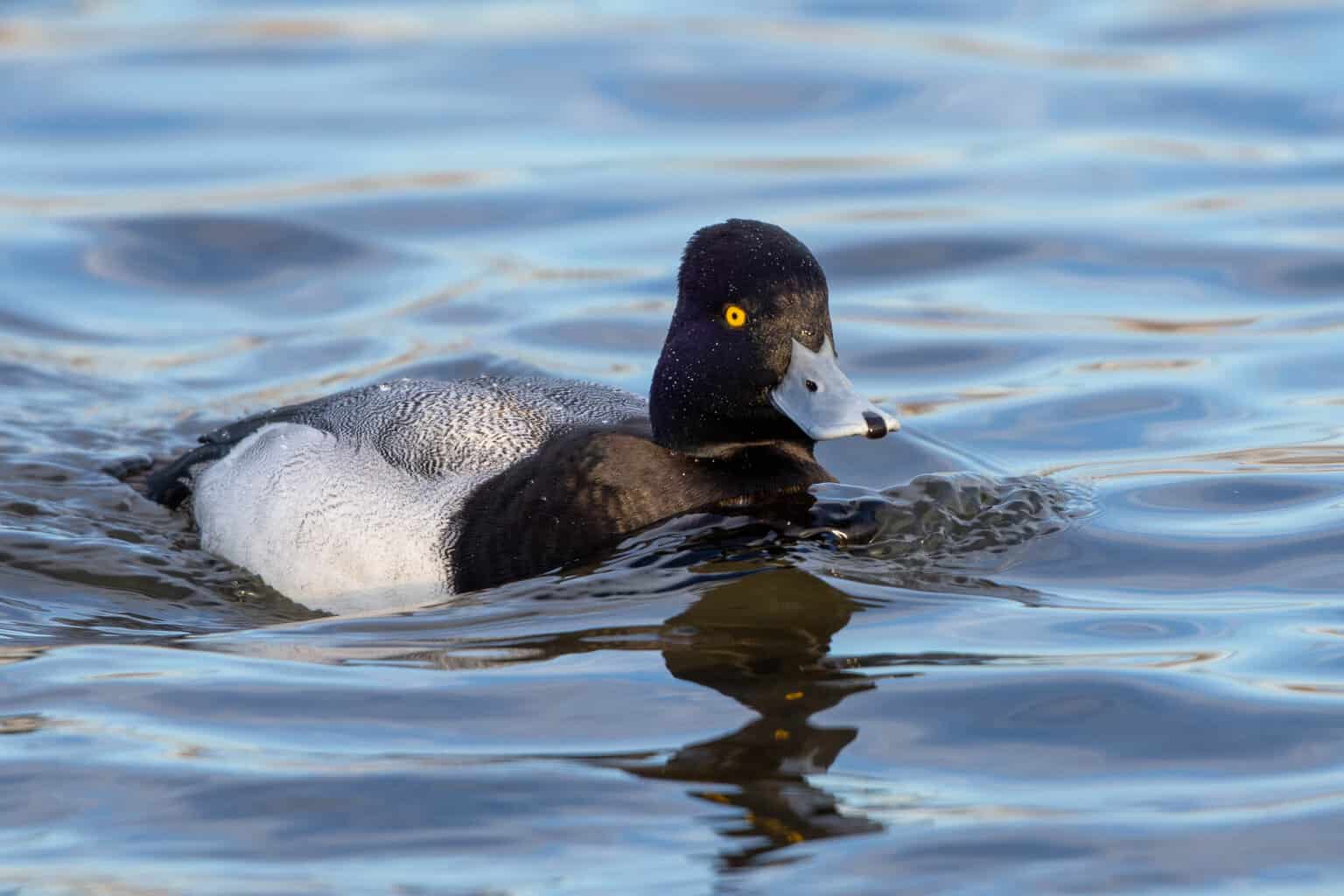
- Aythya affinis
- Length: 15 – 18 in (38 – 49 cm)
- Weight: 40.77 oz (1155 g)
- Wingspan: 24 – 33 in (61 – 84 cm)
Oklahoma is one of many states that is home to both Greater and Lesser Scaup. In the panhandle and across northern Oklahoma, you’ll see them when they migrate between summer and winter habitats.
In central and southern Oklahoma, they’re here for the winter.
The fastest way to differentiate between Lesser Scaup and Greater Scaup is to look for a few stray hairs at the top of the head, creating a tiny little crest. That’s a Lesser Scaup.
Males have purplish-black heads, white sides, and thin gray bars across most of the body, as well as golden-yellow eyes. Females are dark brown, but they have a white patch on their faces.
Lesser Scaup will play dead to escape predators. They spend the winter in huge groups, so if you see a massive number of ducks on a lake or pond, they could easily be Lesser or Greater Scaup.
Mallard (Dabbling Duck)
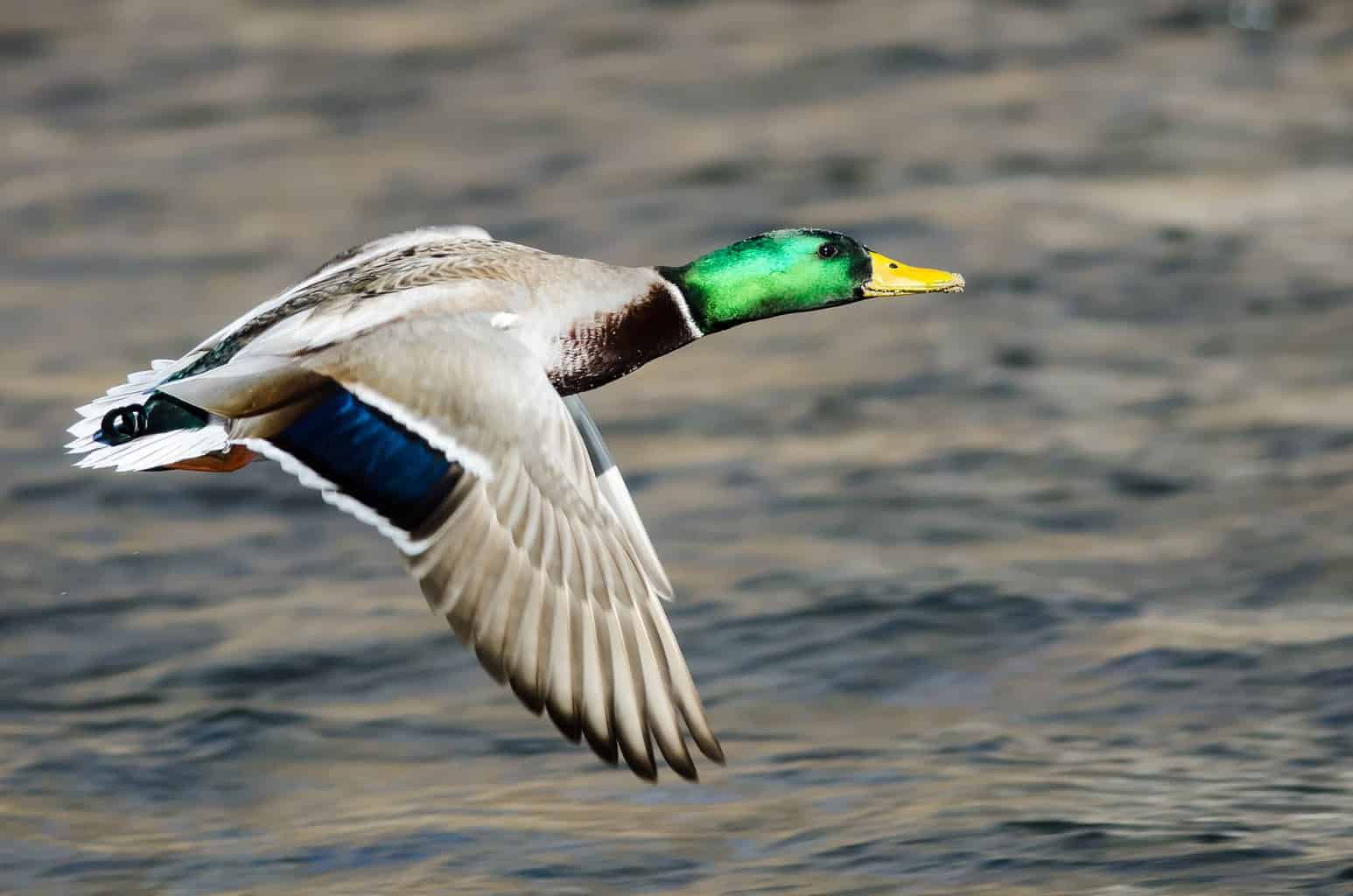
- Anas platyrhynchos
- Length: 19.7 – 25.6 in (50 – 65 cm)
- Weight: 35.3 – 45.9 oz (1000 – 1300 g)
- Wingspan: 32.3 – 37.4 in (82 – 95 cm)
Mallards are the most populous duck in the US, so it’s really not too surprising that they top the list of most commonly sighted ducks in numerous states – including Oklahoma.
It also helps that Mallards are so easy to recognize! Mallards are well-loved by birders, hunters, and duck enthusiasts, to the point that they are frequently represented in art, home decor, jewelry, and even kids’ toys.
- Love, play, cuddle and squeeze! Squishmallows are the softest, cutest plush toys around!
- Meet Avery the Mallard Duck! Featuring soft plush fabric, Squishmallows have their own style and personality encouraging fun and...
- The snuggle is real! The large squishy plush makes for the perfect cuddle companion! These super soft, collectible plush toys are...
Last update on 2024-04-15 / Affiliate links / Images from Amazon Product Advertising API
Males have an iridescent green head, bright yellow bill, gray body, brown breast, and blue speculum. Females have speckled, light brown heads. Her body is darker brown and is both streaked and mottled.
Mallards are aggressive ducks who will fight each other for territory and mates. Their fights will leave them bleeding and missing feathers.
Males are also sexually aggressive toward females, which is why many people view Mallards as beautiful but troubling in their behaviors.
Mottled Duck (Dabbling Duck)
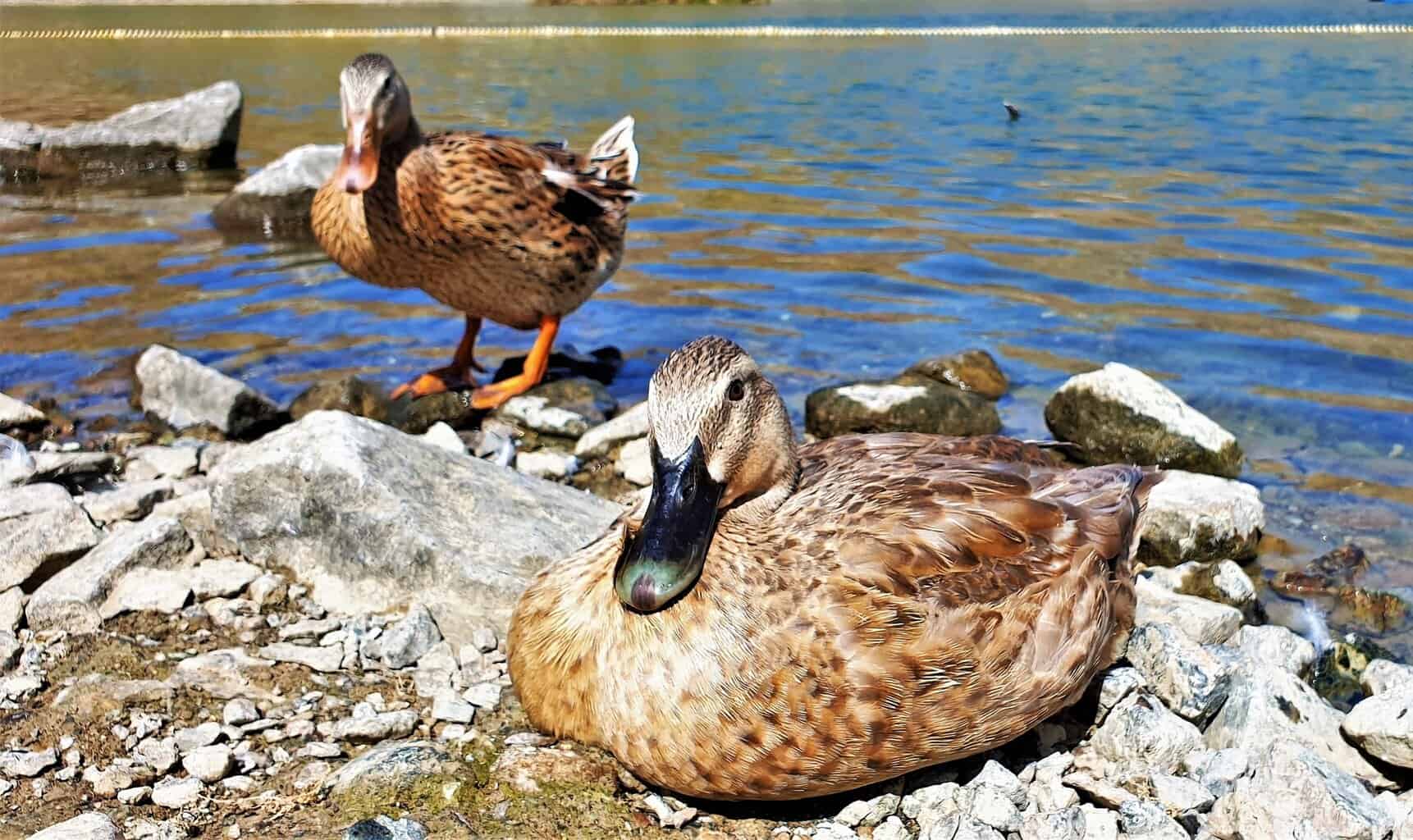
- Anas fulvigula
- Length: 18.5-21 inches
- Weight: 24.7-40.6 ounces
- Wingspan: 31.5-34.3 inches
The Mottled Duck is most commonly found in Florida and along the Gulf coast.
However, some Mottled Ducks do make it as far as Oklahoma during the breeding season. You’re not likely to see a Mottled Duck in this state, but you might get lucky!
Males and females look very similar. They both have streaked feathers, ranging from light to dark brown. They have yellow bills, although the female’s bill has a hint of green. Females are a little less vibrant in their coloring, but otherwise, their markings are about the same.
According to the Audubon Society, “Mottled Ducks are almost never seen in large flocks, generally traveling in pairs or small groups. A major threat to their survival is the release of numerous pet Mallards in Florida and elsewhere in the southeast; these feral birds interbreed with Mottled Ducks, diluting the wild population of the latter.”
Northern Pintail (Dabbling Duck)
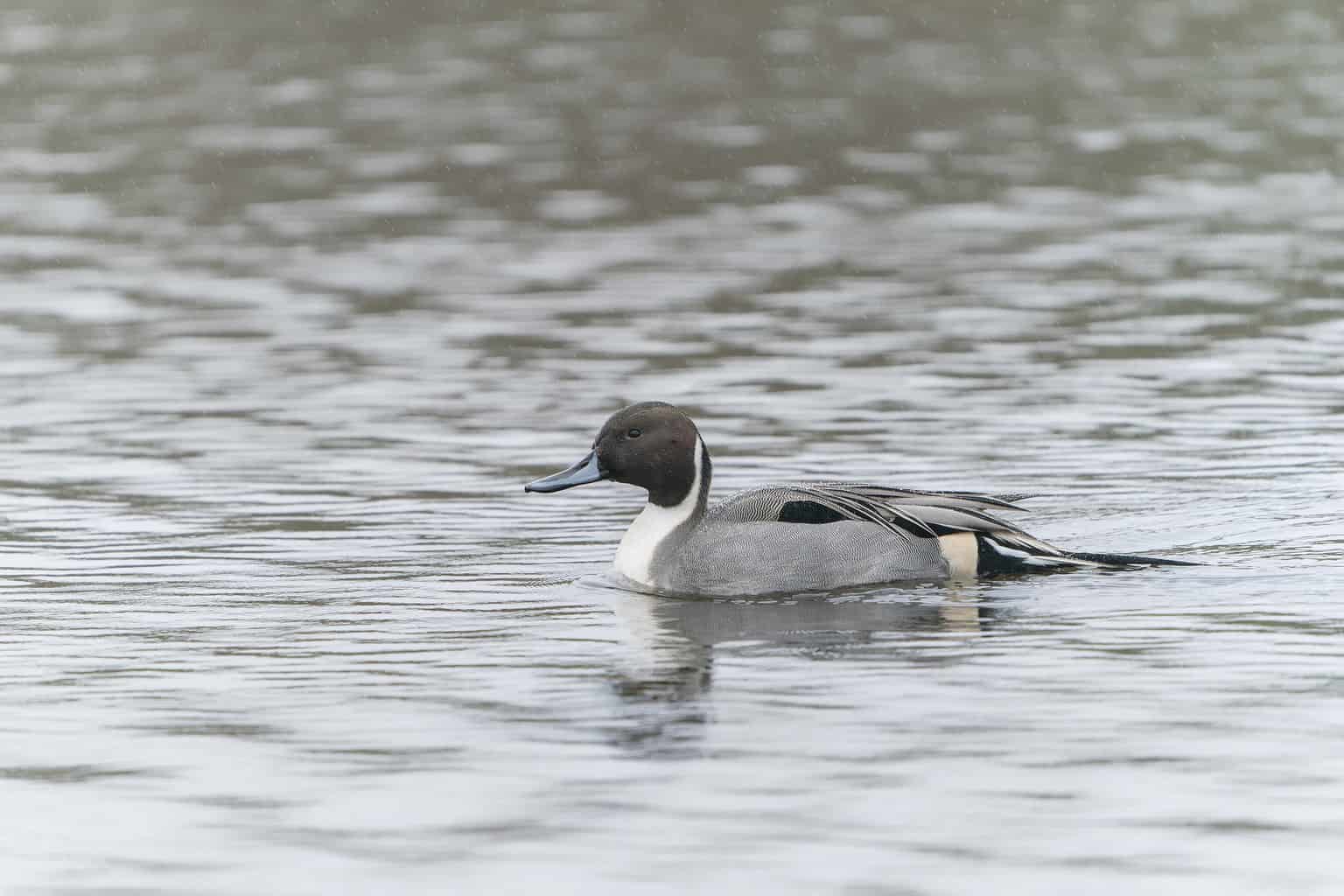
- Anas acuta
- Length: 20 – 26 in (51 – 66 cm)
- Weight: 36.33 oz (1030 g)
- Wingspan: 29 – 35 in (74 – 89 cm)
The Northern Pintail gets its name from the long, pointed tailfeathers that the male sports during the breeding season.
They are also incredibly fast ducks, flying up to 48 mph. This makes them a popular challenge for duck hunters.
Males’ tails are longer, but females have equally pointed tails. Females also have an intricate pattern of dark brown scales across their light brown bodies.
Males have brown heads with a white stripe that runs down the neck. Their bodies are white, gray, and black, and they have a green speculum.
These are winter residents in Oklahoma. Even though they are dabbling ducks, they can reach food that is deeper under the water because they have elongated necks.
They are early-season migrants in the fall, so they arrive in Oklahoma before many other wintering ducks. They will sometimes arrive in August – clearly far before it’s really winter. They live in freshwater habitats and spend their time in very large groups.
By early April, they will be some of the first ducks to leave Oklahoma for their breeding territory, which spans most of Canada and Alaska.
Northern Shoveler (Dabbling Duck)
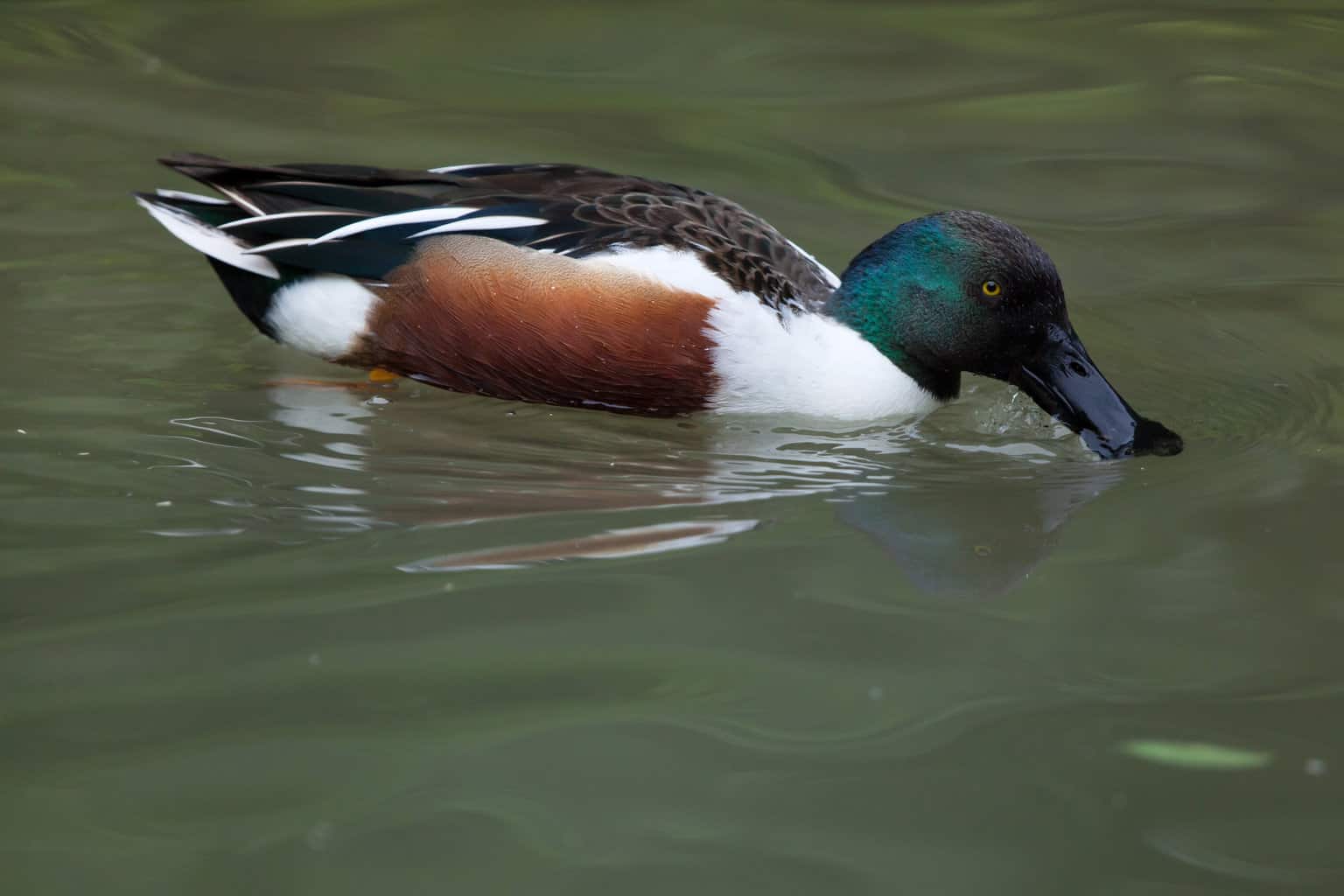
- Spatula clypeata
- Length: 17.3 – 20.1 in (44 – 51 cm)
- Weight: 14.1 – 28.9 oz (400 – 820 g)
- Wingspan: 27.2 – 33.1 in (69 – 84 cm)]
The male Northern Shoveler has a green head that is reminiscent of a Mallard’s head – but there is no way to confuse these two ducks!
Shovelers have thick, broad, black bills that are sometimes described as spoon-shaped or spatula-shaped. That’s where they get their name; they use the bill to “shovel” water into their mouth, and then they use their teeth to strain out the water but catch all of the plants and aquatic critters it caught.
Water pours out of the bill while the Shoveler gets its meal!
Both sexes have this spatula-shaped bill, but the female’s bill is brown compared to the male’s black bill. They prefer shallow standing water, as opposed to flowing rivers or the ocean.
They can be spotted throughout the entire state during the winter.
Like some other ducks, Northern Shovelers will defecate on their own eggs to make them less desirable to predators. They are especially likely to do this when they feel threatened.
Because they are only in Oklahoma during the winter, though, this is not a habit you will witness firsthand.
Red-Breasted Merganser (Diving Duck)
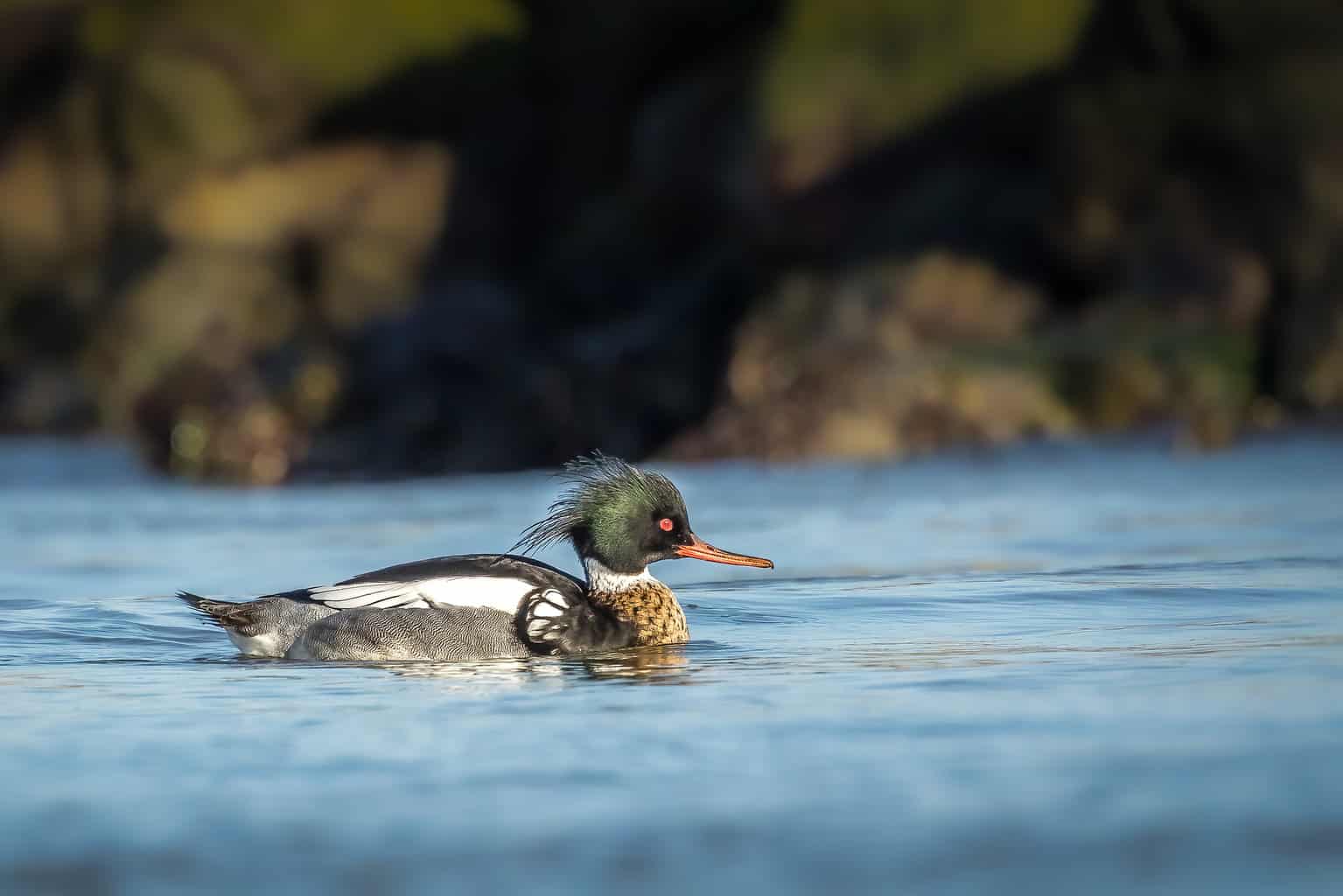
- Mergus serrator
- Length: 16 – 26 in (41 – 66 cm)
- Weight: 47.61 oz (1349 g)
- Wingspan: 31 – 35 in (79 – 89 cm)
The male Red-Breasted Merganser’s spiky, shaggy crest sits atop his very dark green head. He has red eyes and a long, thin, orange sawbill, as well as a white ring around his neck. He doesn’t reach his full sexual maturity or breeding coloring until he is 2 years old.
Females have cinnamon-brown heads with an equally shaggy crest as the males. They have white throats, gray bodies, and red eyes.
During the breeding season, Red-Breasted Mergansers live in the broad coniferous forests that stretch across Canada. They migrate through most of lower Canada and the US to the coasts. They are present in Oklahoma during these migratory periods.
Redhead (Diving Duck)
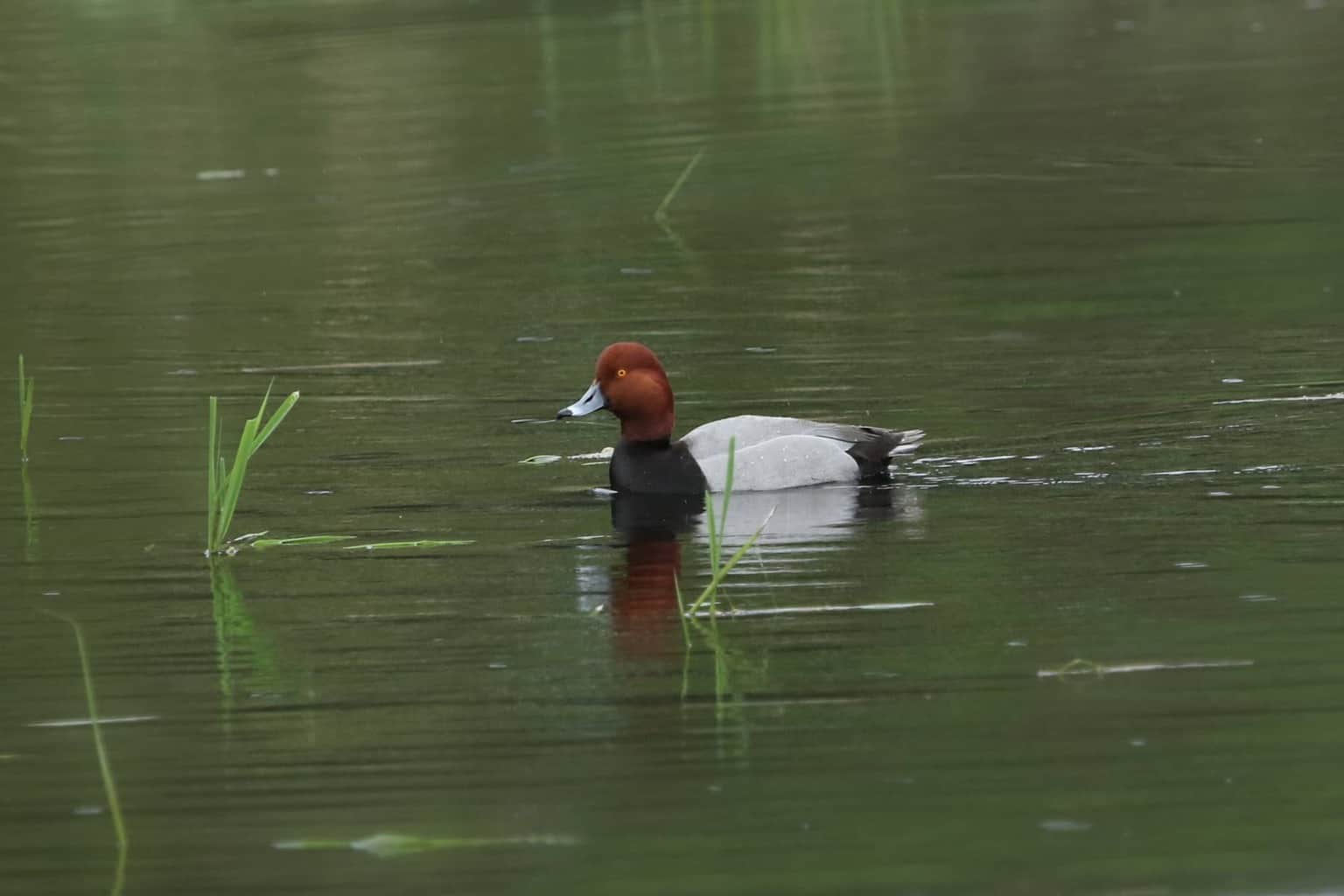
- Aythya americana
- Length: 18 -22 in (46 – 56 cm)
- Weight: 43.03 oz (1219 g)
- Wingspan: 29 – 35 in (74 – 89 cm)
You’ll know a Redhead quickly when you encounter one.
Males have dark, copper-colored heads with gray and black bodies. His bill is dark gray or slate blue with a black tip.
Female Redheads lack much distinction in their patterns and markings, but they can be identified by their brown bodies and a bill that looks just like the male.
They are found in Oklahoma in the winter, although predominantly in the southern half of the state. They are usually only spotted along the northern border and panhandle during their spring and fall migration windows.
Redheads don’t always participate in brood parasitism, but it’s not an uncommon practice for this species.
This consists of laying eggs in other ducks’ nests, rather than their own. Brown-Headed Cowbirds do the same, but they have evolved to the point that they don’t even make nests.
Redheads build nests and hatch their own eggs, but they increase their chances of successful reproduction by leaving eggs in other ducks’ nests.
Ring-Necked Duck (Diving Duck)
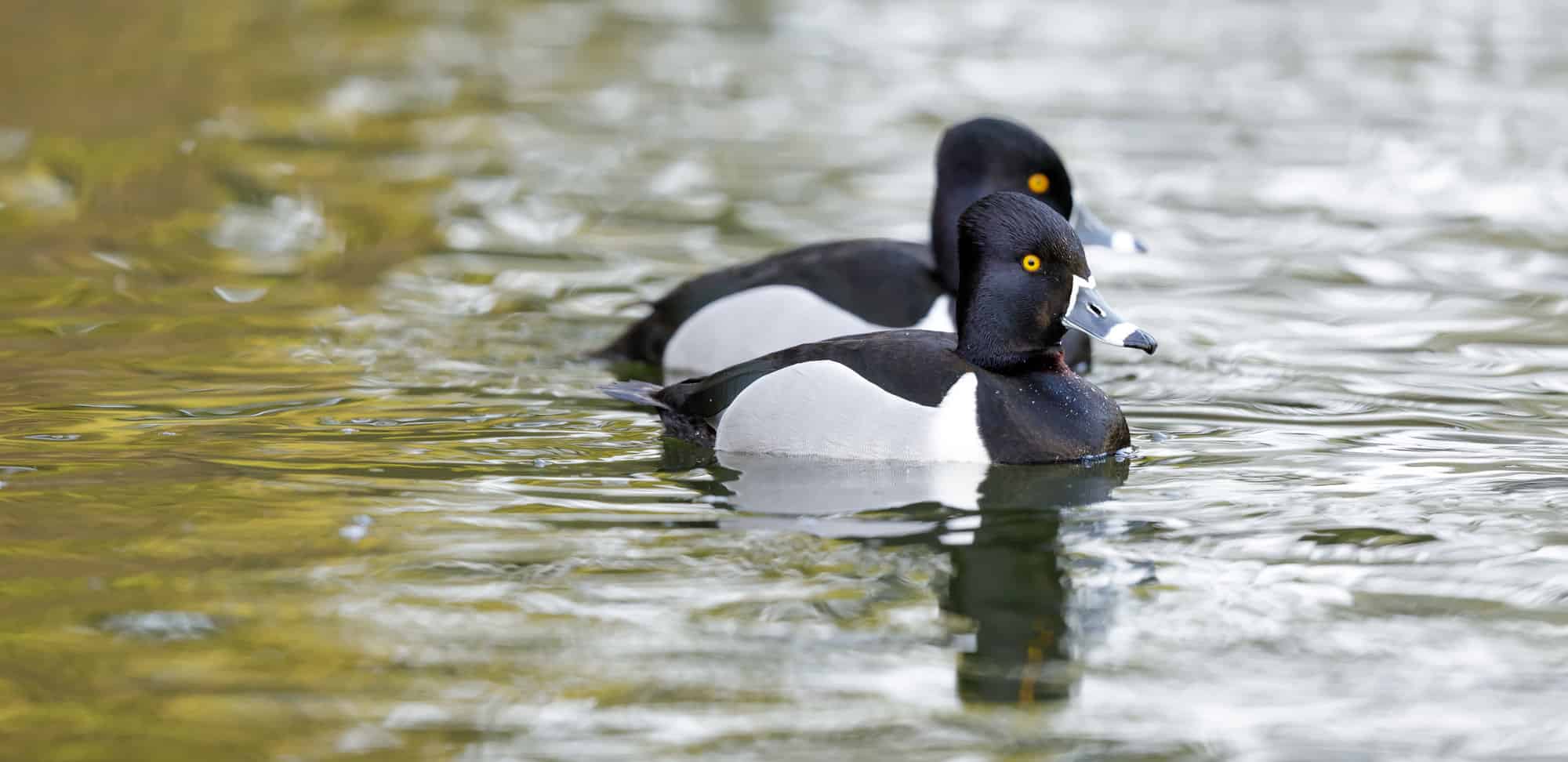
- Aythya collaris
- Length: 14 – 18 in (36 – 46 cm)
- Weight: 32.09 oz (909 g)
- Wingspan: 24 – 30 in (61 – 76 cm)
Ring-Necked Ducks are another duck that spends summer in Canada and migrates south for the winter. Their winter territory includes southern Oklahoma but excludes the northern half of the state and the panhandle.
Even though their name implies otherwise, Ring-Necked Ducks don’t have a noticeable ring on their neck. Instead, they have a white ring around their bill and a white band around their bill, near the tip.
The male has a black chest and back, a white belly, and a black head. The female has a brown body, a gray face, and a white outline around her eyes. She has a white stripe around her bill, but no ring around its base.
Why are they called “ring-necked” if they don’t have a visible ring? There are a few theories, but the prominent explanation is that naturalists who were naming this species in the 1800s only handled dead specimens, and the very subtle copper ring around the duck’s neck must have stood out to them.
There are always at least some of them in Oregon throughout the year, but they are most commonly found in the winter and during their fall and spring migration windows.
Ruddy Duck (Diving Duck)
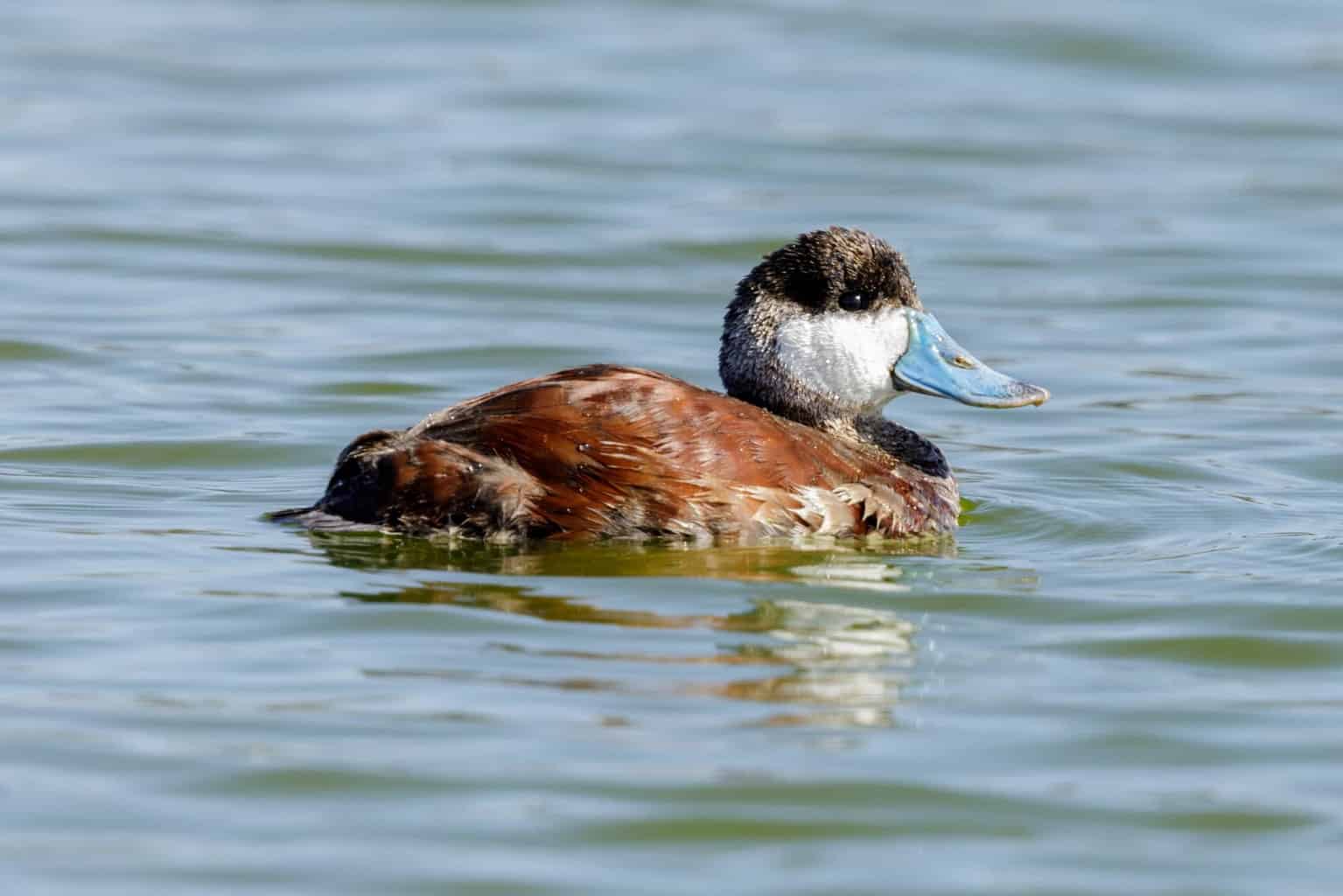
- Oxyura jamaicensis
- Length: 14 – 16 in (35.56 – 40.64 cm)
- Weight: 28.04 oz (795 g)
- Wingspan: 21 – 24 in (53 – 61 cm)
Male Ruddy Ducks are a dull gray in the winter, but their breeding season colors are vibrant and reddish-brown. Additionally, males have a black cap, a large white cheek patch, and a broad, blue bill.
Females are brown-bodied, and their cap is brown as well. They have a cheek patch that is gray instead of white. Instead of a thick blue bill, the female has a black bill.
You’ll have the opportunity to see both winter and summer plumage on these ducks, thanks to the fact that they are year-round residents of Oklahoma. In the summer, you’ll find them in freshwater areas, including marshes, the edges of lakes, and ponds.
Ruddy Ducks are brood parasites to a minor degree; they build their own nests but might lay an egg here or there in a different duck’s nest.
Wood Duck (Dabbling Duck)
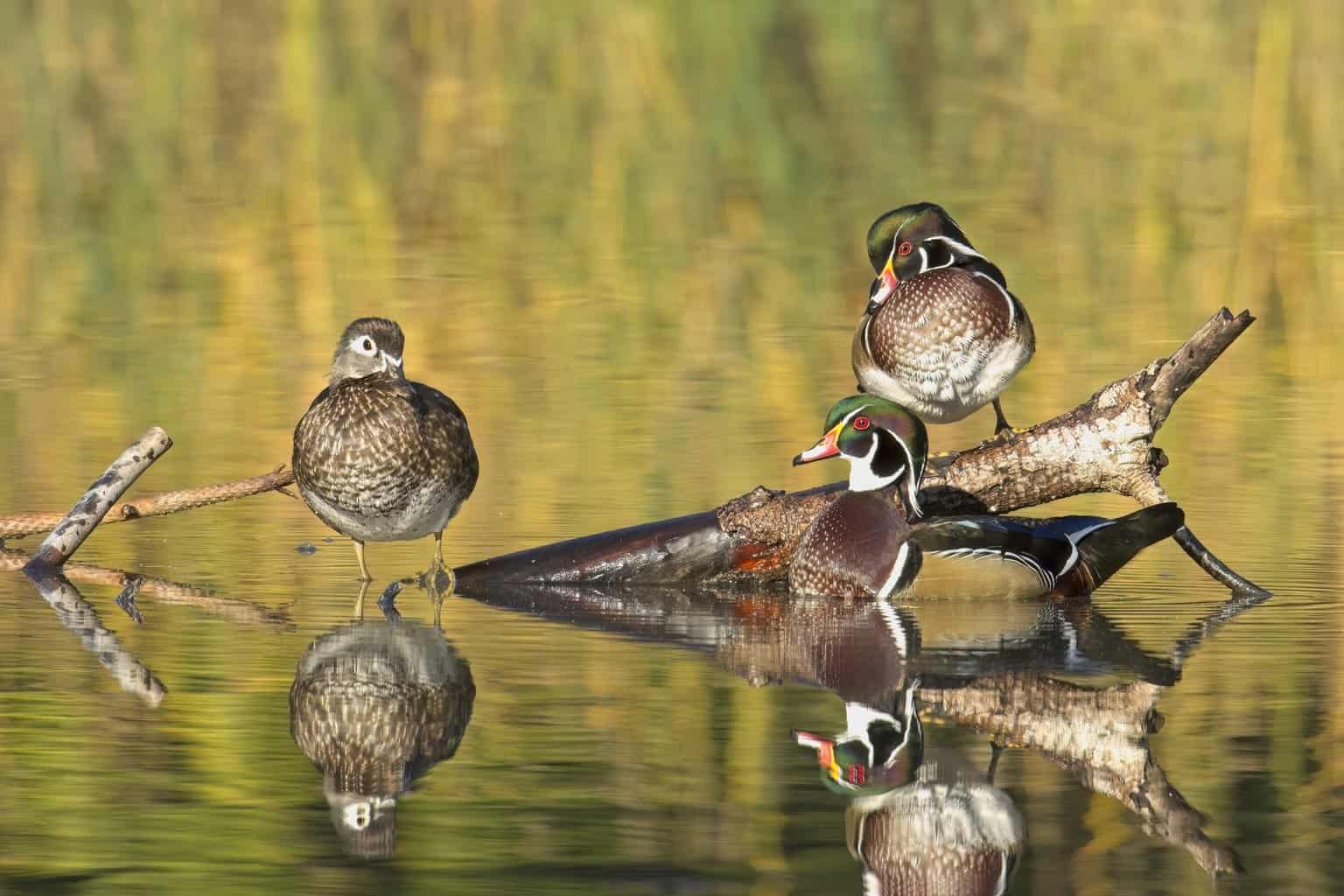
- Aix sponsa
- Length: 18.5 – 21.3 in (47 – 54 cm)
- Weight: 16.0 – 30.4 oz (454 – 862 g)
- Wingspan: 26.0 – 28.7 in (66 – 73 cm)
Wood Ducks are beautiful, and they are visible in eastern Oklahoma year-round. They are winter residents of western Oklahoma.
Wood Ducks have shimmering, iridescent green heads that look a bit like a Mallard’s head. One big difference is the long crest at the base of the head.
Males have chestnut-brown chests and buff sides. Their backs and tails are brown, but they have white markings over most of the body.
Females are brown, and their heads are gray. Females also have a blue speculum.
Wood Ducks live in empty tree cavities that are very close to the water. They nest high in the tree – up to 60 feet above the ground! They are found close to rivers, wetlands, swamps, and ponds.
With a primarily seed and nut-based diet, they will sometimes eat aquatic plants, insects, tadpoles, and salamanders.
One thing that makes the Wood Duck different from all other North American ducks is that the female will lay two clutches of eggs every year. By raising two broods, she has a significantly better chance of passing on her genes and reproducing successfully.
The Final Word – Ducks in Oklahoma
I hope this list has revealed to you just how many ducks are present in Oklahoma!
With 21 ducks that are either regular inhabitants or consistent migratory visitors, there are so many interesting ducks to see while you’re here!
It’s worth noting that ducks are more common in Oklahoma in the winter, as the climate and available habitats are perfect for most non-breeding season ducks.
A few species (Mallard, Mottled Duck, Redhead, Ruddy Duck, and Wood Duck) are here year-round, and the Blue-Winged teal is the only duck that is a summer-only resident.
Of course, ducks aren’t the only fascinating birds in Oklahoma! The Sooner State, as it’s called, is home to countless other bird species, including the ones we’ve written about in our Bird Guide for Oklahoma!
Whether you’re visiting the state or live here, start paying attention to the ducks you see in the waterways on a regular basis.
Once you start identifying ducks, you might not be able to stop!
By traveling to more remote waterways with some essential gear (like spotting scopes, tripods, binoculars, and a good notebook), you’ll be adding plenty of ducks to your bird list before you know it!

